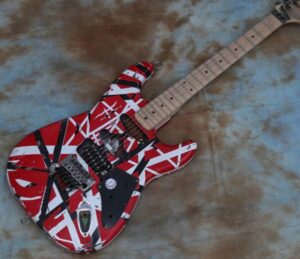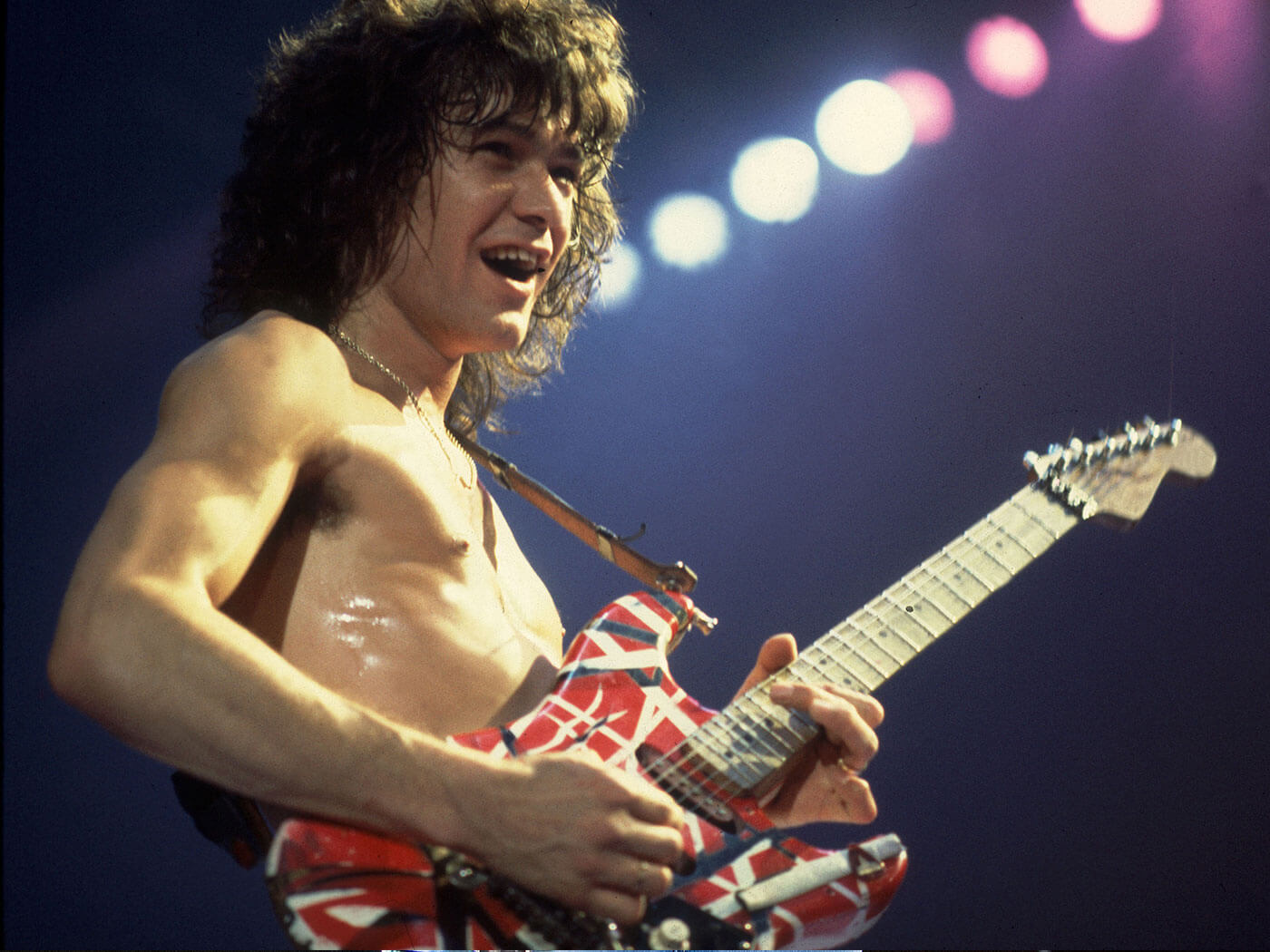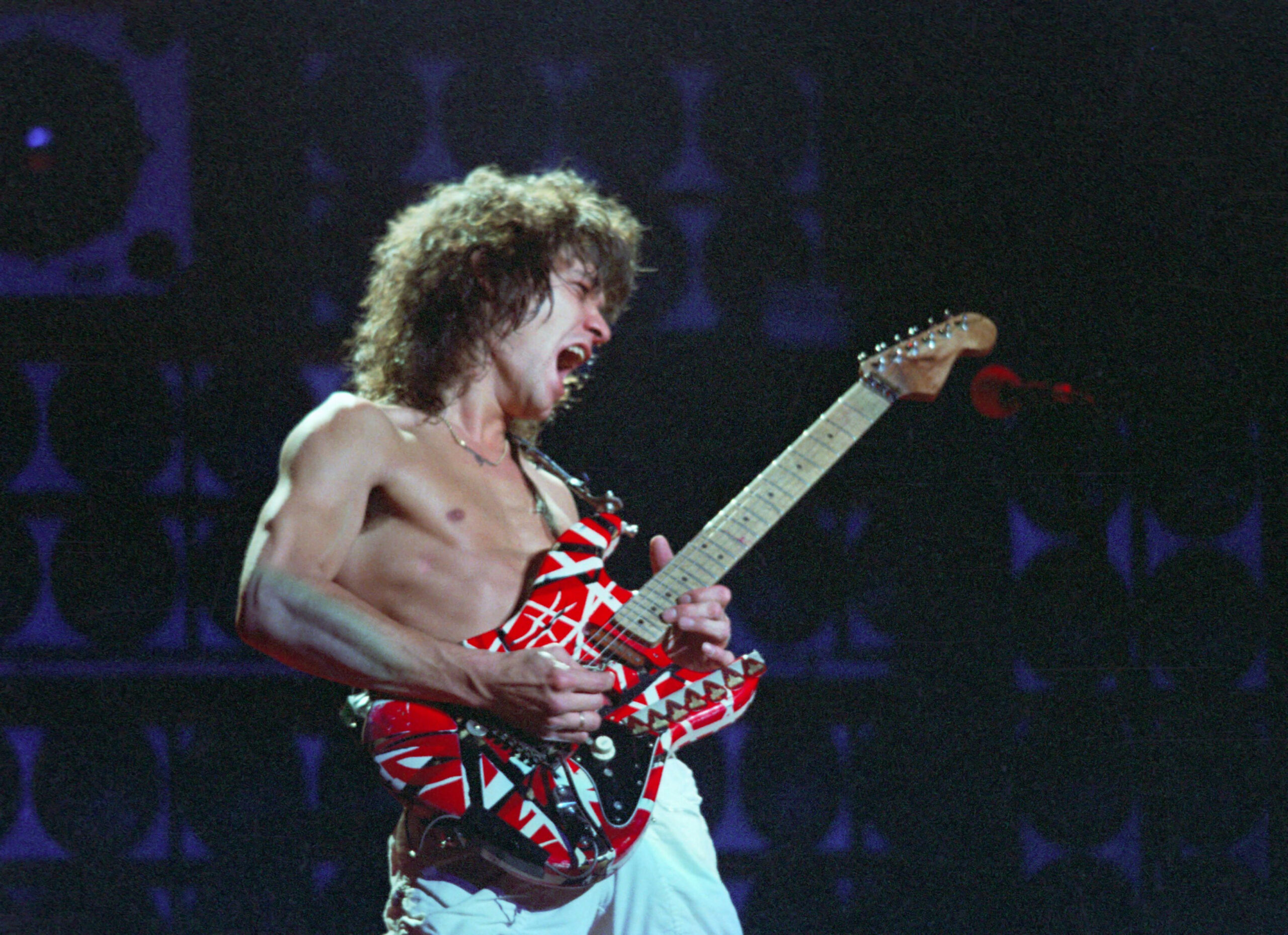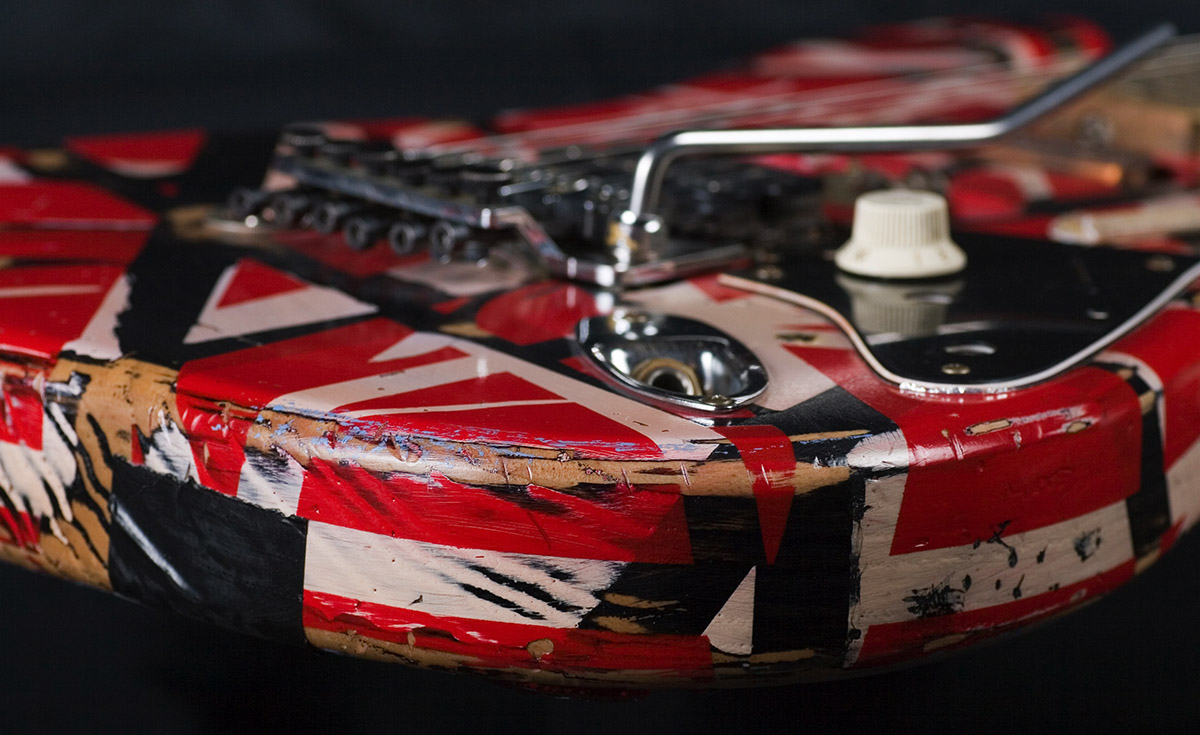 Around early 1977, Eddie purchased a Stratocaster body from Boogie Bodies shop, owned by Wayne Charvel and Lynn Ellsworth. The popular theory is that he also purchased a neck that same day, went home, and pieced together the parts creating the infamous Frankenstrat guitar. However, it’s most likely that the nack was purchased later, as we’ll soon explain.
Around early 1977, Eddie purchased a Stratocaster body from Boogie Bodies shop, owned by Wayne Charvel and Lynn Ellsworth. The popular theory is that he also purchased a neck that same day, went home, and pieced together the parts creating the infamous Frankenstrat guitar. However, it’s most likely that the nack was purchased later, as we’ll soon explain.
Frankenstein Guitar Parts
The body that Eddie picked for Frankenstein was a factory-second unfinished one, which was apparently the first one that he saw lying around the shop.
According to Eddie, he made some requests for the body to be modified by Charvel.
We also learn that he paid close attention when choosing the neck – he looked for a wide neck with a really thin profile and big Gibson-style frets. Also, it sounds like the neck was purchased at a later date, and that he ordered it in advance – which breaks up the hypothesis that the body and the neck were purchased at the same time.
Lastly, Eddie mentioned using a tremolo from a ’58 Stratocaster on the Frankenstrat. As far as one can tell, Eddie did own a 1958 Stratocaster in the earlier years, but according to his own words, he ended up selling it.
He then used a 1961 Fender Stratocaster before he assembled the Frankenstrat, so maybe this is a case of him remembering details incorrectly. It doesn’t seem to make a lot of sense that he would sell the ’58 to someone without a tremolo.

Early Days, Frankenstrat Before the Paint
The first time that the Frankenstrat was used was in early 1977.
At that point, the only actual “Frankenstrat” part on the guitar was the body, and possibly the tremolo. The neck was most likely taken from Eddie’s 1961 Strat, the pickguard was probably a brand new black one, and the “zebra” humbucker pickup was something that we didn’t see in any of Eddie’s previous guitars. In any case, it wasn’t the one that he eventually settled on – it was there just temporarily.
If you want to go more in-depth regarding these early days, and the Frankenstrat before the custom paint job, John Burgess did a great video titled “Bare Body Frankenstrat! Mysteries Revealed!” analyzing wood grain and small details on the body, confirming that this was indeed the earliest version of the Frankenstrat.
First Paintjob
The first paint job that Frankenstrat ever got was in a plain black color. The guitar was photographed in this state at the Whisky A Go-Go on May 29, 1977, by Kevin Estrada.
The rest of the specs practically remained the same as when the guitar didn’t have a finish. It was fitted with a white pickguard, with two single-coils, and a humbucker in the bridge position, it had the same 1961 neck, same tremolo bridge.
Van Halen I, Second Paintjob, White Lines Added
Sometime in 1977, Eddie decided to once again modify the guitar. He repainted the body partially, adding strips of tape over it, and painting the rest with a white spray can. Removing the tape, of course, revealed the old black finish, and left black stripes across the body.

Eddie also replaced the 1961 rosewood fretboard neck with a custom-made maple one from Boogie Bodies. As pointed out in the quote from the first section of this page, Eddie was after a flatter and wider neck, and the 1961 Stratocaster neck that he was using prior to this one, was really on the opposite side of that spectrum.
The Boogie Bodies neck was left completely unfinished, with no lacquer or any sort of wood protection on it. Jokingly, Eddie added a Gibson sticker to the headstock, as the whole idea behind this guitar was to make a crossover between a Fender and a Gibson.
As far as pickups, the white humbucker was gone and was replaced with a black one, most likely taken directly from Eddie’s Gibson ES-335.
Also worth pointing out that at least during this period, Eddie used a plain black pickguard on the Frankenstrat, with a single cutout for the humbucker in the bridge position. According to Eddie, he made this pickguard by himself.
Based on Chris Gill’s research [The true origins and evolution of Eddie Van Halen’s legendary Frankenstein guitar], the guitar was first seen in this state on July 15, 1977, at Whiskey A-Go-Go.
Also based on Chris’ research, the Frankenstrat initially had two control knobs, one of which was later removed. But, in the quote above it sounds like Eddie only really used a single volume knob, so it’s unclear whether this second pot was even functional or not.
In any case, Eddie used this version of the Frankenstrat on Van Halen’s debut album, likely on all of the songs that required tremolo use. On the other ones, he used his Ibanez Destroyer. He also used the guitar for the band’s 1978 tour.
White pickguard, Rosewood fretboard neck

The guitar was once again modified by Eddie likely sometime after the 1978 tour. There’s only one photo available of the guitar in this state, taken by Lynn Goldsmith, and published on Getty.
From the looks of it, Eddie went back to his old ’61 white pickguard, based on the fact that the screw placement above the middle pickup matches that of a 1961 Stratocaster. The bridge pickup seems to be the same black PAF from the ES-335, while the middle and the neck pickups are completely new to this guitar.
The middle pickup looks like a Telecaster pickup, based on the method that it was attached to the pickguard – via three screws, the same you’ll find on a Telecaster bridge pickup. The neck pickup was most likely the same red-colored Mighty Mite pickup that remained in the guitar to this day.
The rosewood fretboard neck that was installed on the Frankenstrat at this point was likely a brand new one, as it didn’t fit the description of the old ’61 neck.
Frankenstrat Goes Red

By the time the band went on their 1979 tour, Eddie once again decided to repaint the guitar. According to him, he did this in order to “screw” with the people who were trying to copy him.
This, chronologically looking, third paint job is the one that the Frankenstrat is today known for. It was a result of the same method that Eddie used the first time – adding lines of tape over the body, and painting the exposed parts with a red spray can.
At this point, the guitar had the same three pickups that were there when it was last seen, a Gibson PAF humbucker, a Telecaster single-coil, and a red-colored Mighty Mite single coil. But, both of the single-coils were not even connected to anything and were there just for the show.
 This incarnation of the Frankenstrat also featured a maple neck with its headstock painted black. This was most likely the same neck that he used originally on the Bumblebee guitar. It seems that he probably liked that neck, so he decided to keep it original on Frankie, while he put a different neck on the Bumblebee, because he needed to modify it in order to install a Floyd Rose locking nut on it.
This incarnation of the Frankenstrat also featured a maple neck with its headstock painted black. This was most likely the same neck that he used originally on the Bumblebee guitar. It seems that he probably liked that neck, so he decided to keep it original on Frankie, while he put a different neck on the Bumblebee, because he needed to modify it in order to install a Floyd Rose locking nut on it.
It’s unclear at this point what happened to the original Boogie Bodies neck with the Gibson sticker on it, but according to photographic evidence, it was never again seen on Frankie.
It’s also worth noting that around 1979 Eddie started gluing reflectors on the back of the guitar. At first, he had only a few, and at some point, even had a small mirror glued back there. The point of all this was so that he could turn the guitar around during the live shows, and shine the light back to the audience – similar to what Syd Barret did with his Fender Esquire in early Pink Floyd gigs.
BELOW A REVIEW OF THE FENDER FRANKIE REPLICA (300 copies)
9.0 Score
Pros
- Distinct and unmistakable sound
- Aesthetically perfect as the original
- Only 300 copies
Cons
- Not for everyone not easy to play
- Expansive around $25,000
- Only for lovers
Final Verdict
This red, black and white ash body guitar has undergone an incredible aging process to replicate the original down to the last detail, dent and cigarette burn. Fender craftsmen even scoured every little detail with even the 1971 ground - just like the original once locked under the original tremolo bridge - to be mounted next to the original Floyd Rose tremolo bridge. The guitar features a Seymour Duncan Custom Shop EVH humbucking pickup, a single master volume knob (that says "Tone") mounted to a partial black pickguard identical to the stock. Leaving nothing to chance, the guitar is complete with a non-functioning three-way switch and single-coil pickups that take up two of the three pickup paths.








Stay connected